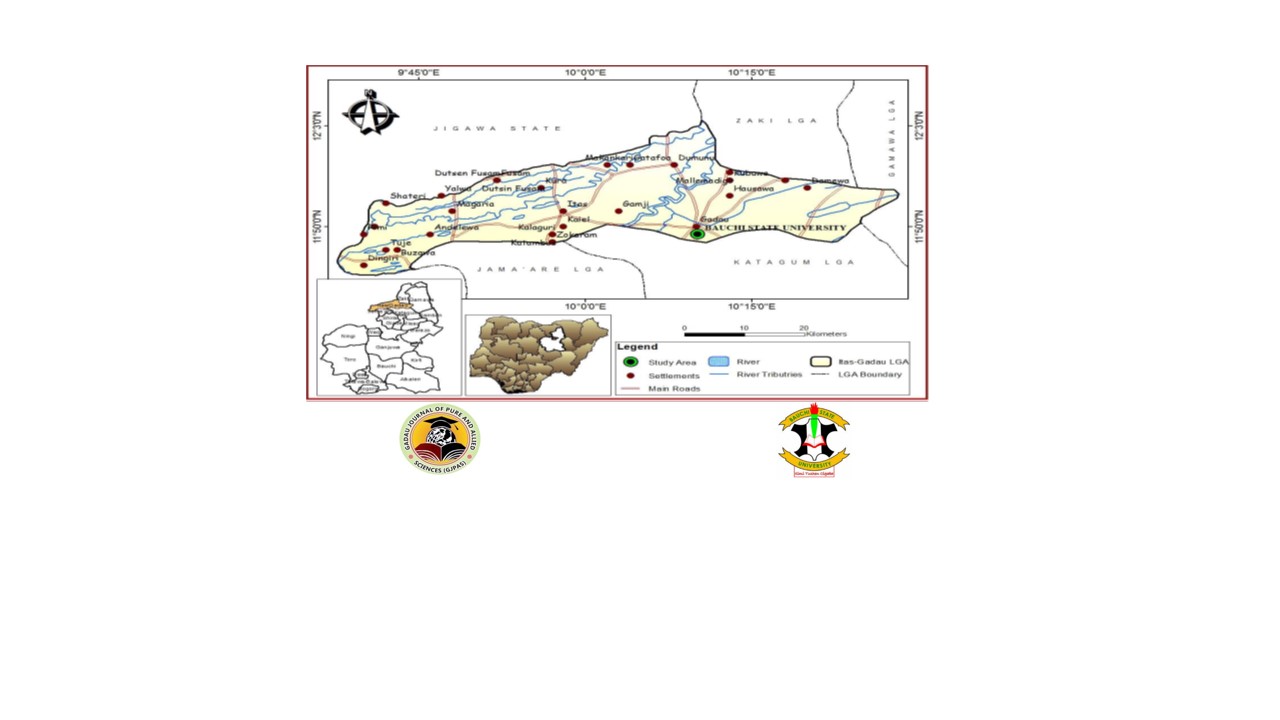Preliminary response of some soya beans varieties (Glycin max) grown on underlying soil of Tamarindus indica
DOI:
https://doi.org/10.54117/gjpas.v2i2.97Keywords:
Underlying, Soil, Soya Beans, Tamarindus, VarietiesAbstract
Soya beans is an important crop with lots of nutritional and economic benefits. This study aimed to find out the implication of growing the crop on an underlying soil of Tamarindus indica. A complete randomised block was employed on three varieties of soya beans (TGX-713-09D, TGX1835-10E, TGX1951-3F) with three replications. Days to germination and germination percentage were observed. The days to germination recorded for the three soya beans varieties did not differ significantly, even though TGX-713-09D variety with 6 days had the highest days to germination while both TGX1835-10E and TGX1951-3F recorded 5 days. The underlying soil of Tamarindus indica had a mean average of 6 days to germination compared to the control which recorded 4 days. The germination percentage for the three soya beans varieties also did not differ significantly. Where both TGX-713-09Dl and TGX1835-10E varieties recorded 89% compared to the 78% recorded by TGX1951-3F. When the treatments were compared, the control had the highest germination percentage (93%) while the underlying soil of Tamarindus indica had 78%. On the contrary, the underling soil of Tamarindus indica did better in terms of plant height, stem girth and number of branches with the values 15.61cm, 2.27cm and 5.33 respectively as against the control which recorded 15.56cm, 2.10cm and 5.11 respectively. Best soya beans variety in terms of plant height, stem girth and number of branches was TGX1835-10E with the values 15.83cm, 2.38cm and 5.50. This study here by recommends planting soya beans close tamarind trees and also recommend the variety TGX1835-10E to farmers.
References
Abdulhameed, A. (2005). Comparative Effects off Albizia Lebbeck and Dalbergia sissoo Trees on Soil Nutrients in Semi Arid Region of Northern Nigeria. Nigerian Journal of Botany 18(1), 197-202
Abdulhameed, A., Abdul, S. D. and Ezra, A. G. (2004). Root Zone Soil and Leaf Mineral Content of Some Savanna Trees in Nigeria. Nigerian Journal of Botany. 17(1), 33-37
Bowe, C., and H. Haq. 2010. Quantifying the global environmental niche of an underutilized tropical fruit tree (Tamarindus indica) using herbarium records. Agriculture, Ecosystems and Environment 139: 51–58.
Carter T Jr, Hymowitz T, Nelson R. (2004). Biogeography, local adaptation, Vavilov, and genetic diversity in soybean. In: D Werner, ed. Biological resources and migration. Berlin, Germany: Springer, 47– 59.
Clarke, E. and Wiseman, J. (2005). Effects of variability in trypsin inhibitor content of soya bean meals on true and apparent ileal digestibility of amino acids and pancreas size in broiler chicks. Animal Feed Science and Technology - ANIM FEED SCI TECH. 121. 125-138.
Hartman GL, West ED, Herman TK. 2011. Crops that feed the World 2. Soybean – worldwide production, use, and constraints caused by pathogens and pests. Food Security 3: 5– 17.
Hymowitz, T., and Newell, C. A. (1981). Taxonomy of the Genus Glycine, Domestication and Uses of Soybeans. Economic Botany, 35(3), 272–288. http://www.jstor.org/stable/4254296
Isichie, A. O. and Moughalu, J. I. (1992). The Effects of Tree Canopy Cover on Soil Fertility in Nigerian Savanna. Journal of Tropical Ecology. 8(1): 329-338
Khojely, D. M., Ibrahim, S. E., Sapey, E. and Han, T. (2018). History, current status, and prospects of soybean production and research in sub-Saharan Africa. The Crop Journal.226-235
Kim MY, Van K, Kang YJ, Kim KH, Lee S-H. (2012). Tracing soybean domestication history: from nucleotide to genome. Breeding Science 61: 445– 452.
Puttaso, A., P. Vityakon, F. Rasche, P. Saenjan, V. Treloges, and G. Cadisch. 2013. Does organic residue quality influence carbon retention in a tropical sandy soil? Soil Science Society of America Journal 77: 1001–1011.
Savage, G.P. and Morrison, S.C. (2003). Trypsin Inhibitors. Encyclopedia of Food Sciences and Nutrition (Second Edition), 2003
Sibylle Faust , Susan Hanisch , Andreas Buerkert and Rainer Georg Joergensen (2015) Soil Properties Under Manured Tamarindus indica in the Littoral Plain of South-Wester Madagascar. Arid Land Research and Management, 29 (2), 167-179.
Xaviera-filho, J. and Campos, F.A.P. (1989). Proteinase inhibitors. In Toxicants of Plant Origin: III. Proteins and Amino Acids,. Ed. P.R. Cheeke. pp. 1-27. Boca Raton, Florida: CRC Press Incorporated.

Downloads
Published
Issue
Section
License
Copyright (c) 2023 Gadau Journal of Pure and Allied Sciences

This work is licensed under a Creative Commons Attribution 4.0 International License.

